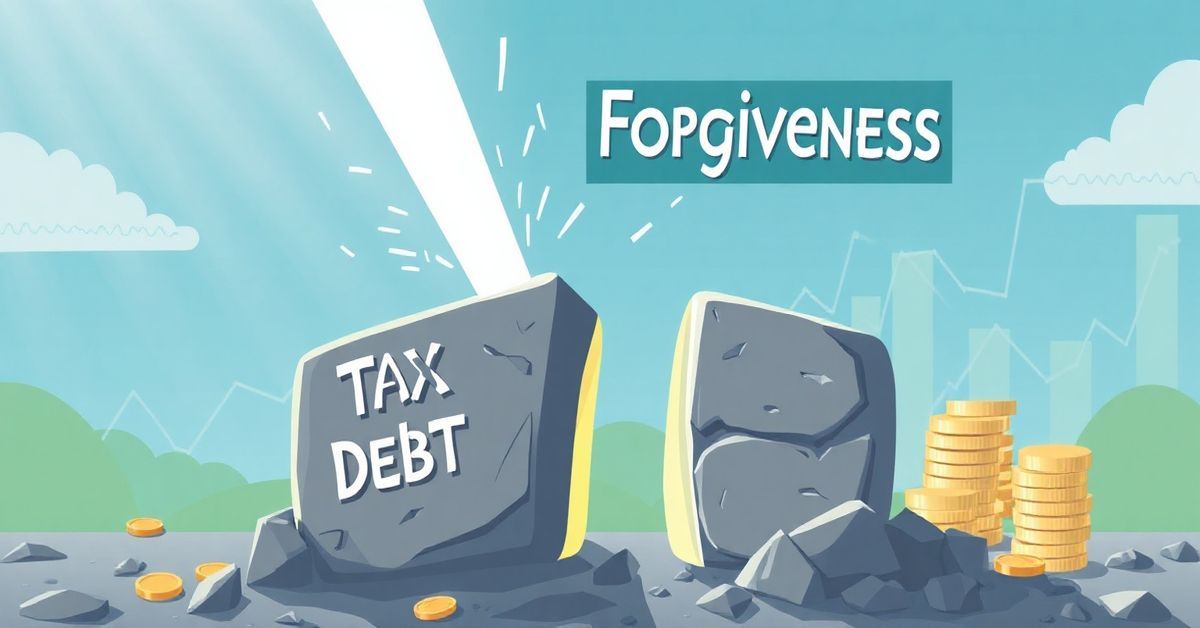Understanding Tax Debt Forgiveness
Dealing with tax debt can be stressful. The idea of owing money to the IRS or your state can be overwhelming. Luckily, there are options for some people to get relief. One such option is called tax debt forgiveness. Essentially, this means that the government agrees to cancel some or all of the taxes you owe. But, how does it work? Let’s dig in.
What are the Common Ways Tax Debt Can Be Forgiven?
Tax debt forgiveness isn’t just a magic wand that makes your debt disappear. There are specific ways this can occur, most of which require some work on your part. Let’s look at the most common methods of tax debt forgiveness:
Offer in Compromise (OIC)
- What is it? An Offer in Compromise (OIC) is an agreement between you and the IRS (or your state tax agency) to settle your tax debt for a lower amount than you originally owed. This is usually when you can prove you can’t pay the full amount.
- How does it work? To make an OIC, you must show the IRS that you’re unable to pay your tax debt, and will likely continue to be unable to pay it. The IRS considers your ability to pay, your income, expenses, and asset equity. They look at whether you can pay the debt off using a payment plan or other available options before approving the OIC.
- Who is it for? This option is for people who are seriously struggling to pay their tax debt and are in a difficult financial situation. The IRS doesn’t grant OICs lightly. You will be required to submit a detailed financial form to prove your financial hardship.
- Important note: There is an application fee for the OIC. You can seek a waiver of the fee if your income is below certain thresholds. Also, the IRS will likely investigate your finances when you submit an OIC. So be prepared to disclose all financial assets.
Insolvency (Cancellation of Debt)
- What is it? This happens when your liabilities (what you owe) exceed your assets (what you own). If your liabilities exceed your assets, you are considered insolvent. If your debt is forgiven, it can be treated as income for income tax purposes.
- How does it work? If your debts are forgiven because you are insolvent, you may not have to pay taxes on the forgiven debt. You can often exclude the amount of debt forgiven from your gross income. This is because if you would have sold assets to pay the debt and not had enough to pay, it would be unfair to tax you as if you received income when you did not.
- Who is it for? This is for individuals who have more debt than they have assets. This can happen to individuals who have high credit card balances, student loans, and other forms of debt. It’s important to keep good financial records if you think you may qualify. It is best to consult with a tax professional if you think you may qualify for this form of tax relief.
- Important Note: It’s essential to know the rules for the exclusion of debt forgiveness income from your tax return. There is a form you will need to fill out and submit with your income tax return (IRS Form 982).
Bankruptcy
- What is it? Bankruptcy is a legal process that can help people who can’t pay their debts. There are different types of bankruptcy, like Chapter 7 and Chapter 13, which have different rules for tax debts.
- How does it work? Chapter 7 can discharge certain types of tax debt, meaning you no longer have to pay them. Chapter 13 involves a repayment plan. Some taxes might be discharged in this process, while others may have to be repaid through the plan. Bankruptcy can be a complicated process, so seek guidance from a lawyer or tax expert if you are considering this option.
- Who is it for? Bankruptcy is generally for those with significant debt problems that can’t be solved any other way. The types of tax debt that can be discharged and the timing of the tax debt is important. For example, you generally can’t discharge tax debt that is not at least three years old.
- Important note: Not all tax debt is dischargeable in bankruptcy, and there are strict rules and time limits on when you can file for bankruptcy. You should consult with a bankruptcy attorney to assess if this is a good option for you.
Special Considerations for Tax Debt Forgiveness
While forgiveness can provide significant relief, it’s not a simple process. Here are some extra things to keep in mind:
Interest and Penalties
- Even if your tax debt is forgiven, you might still owe interest and penalties. Interest continues to accrue on unpaid balances and can add to the overall amount you owe. When considering an OIC, for example, interest and penalties may not be reduced. Make sure you understand how the interest and penalty rules work and how your debt forgiveness will be applied.
State vs. Federal Tax Debt
- Tax debt forgiveness rules can differ significantly between the IRS and state tax agencies. What works at the federal level may not work at the state level. State tax agencies have their own procedures and criteria. So, it’s crucial to check both federal and state requirements.
Tax Implications of Forgiveness
- As mentioned above, the IRS generally treats forgiven debt as income that you may have to pay taxes on. However, some exceptions can be excluded, such as those due to insolvency. It is important to carefully track any forgiven debt, and you may want to consider filing for an exemption to avoid paying tax on forgiven debt. Seek professional tax advice in these situations.
Common Mistakes and Misconceptions
It’s easy to get confused about tax debt forgiveness. Here are some things to avoid:
- Thinking it’s automatic: Forgiveness is not automatic. You need to apply and meet specific eligibility criteria. The IRS does not just forgive tax debt. There is a process you must follow.
- Ignoring notices: Never ignore notices from the IRS or state tax agencies. Always promptly respond and follow any instructions provided in the notices. Even if you cannot pay the full balance of taxes due, respond to the notice so that you can potentially set up a payment plan or offer in compromise.
- Trying to do it alone: Tax laws and forgiveness rules are complicated. It’s often best to seek advice from a qualified tax professional who can help guide you through the process. A tax professional can help you avoid making costly mistakes.
- Expecting a quick fix: The tax debt forgiveness process can take time. It may take a while to get approval for an OIC, or the legal processes for bankruptcy can be lengthy. Patience and persistence are key.
- Misunderstanding bankruptcy: Not all tax debts are discharged in bankruptcy, and there are specific rules to follow. It’s crucial to understand this if you’re considering bankruptcy. You may be able to discharge certain types of tax debt but not others.
Tips for Managing Tax Debt
Even if forgiveness isn’t an immediate option, here are some strategies:
- Communicate with the IRS: Contact the IRS or your state tax agency as soon as you know you have a problem. Ignoring it will only make things worse. They often have payment plans available for tax debt.
- Set up a payment plan: If you can’t pay the full amount, see if you can set up an installment plan with the IRS. This can help you manage your debt over time.
- Keep good records: Keep accurate records of your income, expenses, and any debt. This will be essential if you apply for forgiveness. Tax authorities may want to examine your records, so you want to make sure that they are accurate and current.
- Be prepared to provide documentation: When applying for forgiveness, you’ll likely need to provide proof of your financial situation. The more organized you are, the faster the process will be.
- Don’t give up hope: Tax debt can feel overwhelming, but many people find solutions. Stay persistent, seek help when needed, and explore all your options.
Related Concepts
- Tax Lien: A legal claim against your property for unpaid taxes. A lien can often be a precursor to a levy.
- Tax Levy: The seizure of your property to pay unpaid taxes. In situations where the IRS levies your assets, this can be disruptive and hard to unwind. It is best to be proactive with tax debts to prevent a levy.
- Installment Agreement: A payment plan you set up with the IRS to pay your debt over time. This is often a good option if you can’t pay in full but also don’t qualify for an OIC.
In Summary
Tax debt forgiveness offers hope for those struggling with unpaid taxes. It’s not a simple process but, understanding your options like Offer in Compromise, insolvency, and bankruptcy can be beneficial in finding the best course of action for your specific financial situation. If you’re facing tax debt, the best thing you can do is seek professional advice. A tax professional or tax attorney can help you explore your options, and get you on the path to financial recovery.

